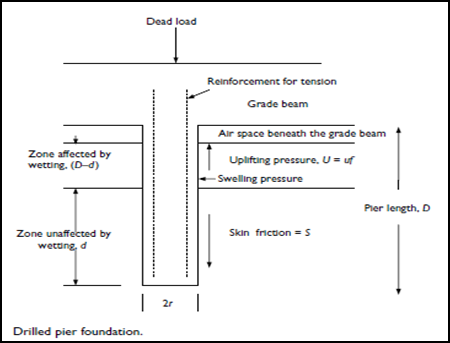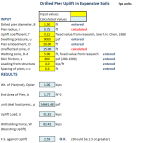Drilled Pier Uplift in Expansive Soils

Description
Soils that exhibit swelling characteristics impose an uplift load to drilled pier foundations. This spreadsheet calculates the uplift load and F.S. against uplift.
Calculation Reference
Bored Pile Design
Drilled Pier Uplift in Expansive Soils
Craig's Soil Mechanics
Drilled piers, also known as drilled shafts or caissons, are deep foundation elements constructed by drilling a hole into the ground and filling it with concrete, often reinforced with steel. They are used to support structures in various soil conditions, including expansive soils.
Expansive soils, such as clay, have the potential to swell when they absorb water and shrink when they dry. These volume changes can exert significant uplift forces on the foundation elements, which can cause distress or failure in the supported structure if not properly accounted for during design.
To address the uplift forces due to expansive soils on drilled piers, the following design considerations should be taken into account:
-
Site investigation: Conduct a thorough geotechnical investigation to determine the soil profile, including the depth, thickness, and properties of the expansive soil layer. This information is crucial for assessing the potential heave and uplift forces.
-
Pier depth: Design the drilled pier to extend below the zone of significant soil expansion to minimize the impact of uplift forces. The depth of the pier will depend on the local soil conditions and the specific design requirements of the project.
-
Pier diameter: A larger diameter pier may be required to resist the uplift forces caused by expansive soils. The diameter should be designed based on the calculated uplift forces and the soil's bearing capacity.
-
Reinforcement: The reinforcement in the drilled pier should be designed to resist the uplift forces and bending moments caused by soil expansion. The reinforcement should extend through the full length of the pier to ensure adequate resistance to uplift.
-
Void forms or soil treatment: In some cases, it may be necessary to use void forms or soil treatment techniques, such as chemical stabilization, to minimize the impact of expansive soils on the foundation system. Void forms can create a buffer zone between the pier and the expanding soil, reducing the uplift forces on the pier. Chemical stabilization can alter the properties of the soil, reducing its potential for expansion.
-
Monitoring and maintenance: Regular monitoring of the structure and the surrounding soil conditions can help identify potential issues related to expansive soils and uplift forces. Maintenance measures, such as proper drainage and moisture control, can help minimize the impact of expansive soils on the foundation system.
When designing drilled piers in expansive soils, it is essential to consult geotechnical engineers familiar with the local soil conditions and follow the relevant design codes and guidelines, such as Eurocode 7 (EN 1997) for geotechnical design and other applicable codes for the specific foundation system.
Calculation Preview
Full download access to any calculation is available to users with a paid or awarded subscription (XLC Pro).
Subscriptions are free to contributors to the site, alternatively they can be purchased.
Click here for information on subscriptions.

